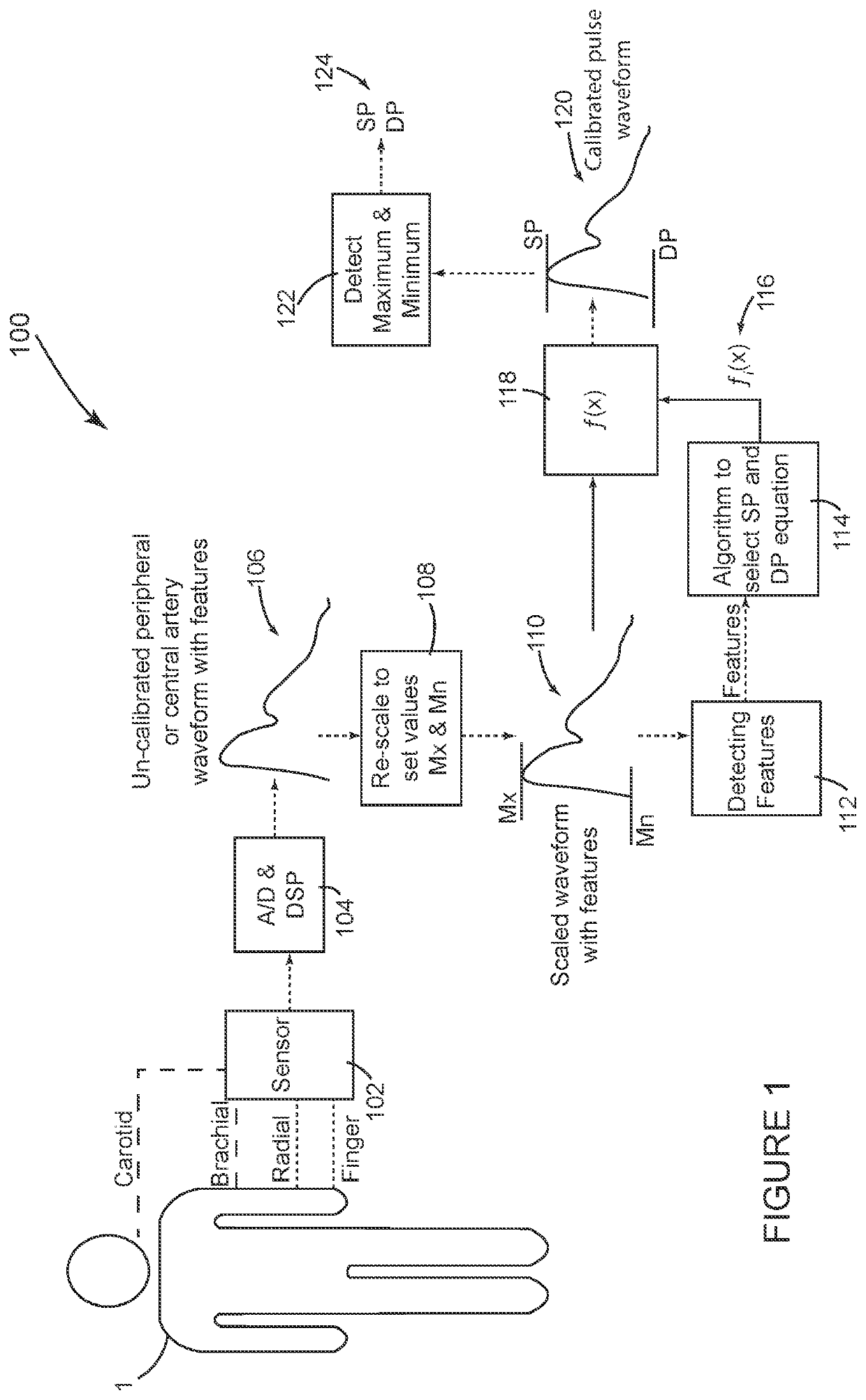Non-invasive blood pressure measurement
a blood pressure and non-invasive technology, applied in the field of measuring systolic and diastolic blood pressure, can solve the problems of reducing the reliability of the cuff nibp in clinical practice, adding to the unreliability of the cuff nibp, and the difference between the cuff nibp and the invasive brachial artery sp and dp typically, so as to achieve continuous and accurate measurement
- Summary
- Abstract
- Description
- Claims
- Application Information
AI Technical Summary
Benefits of technology
Problems solved by technology
Method used
Image
Examples
first embodiment
[0033]FIG. 1 shows a system 100 configured in accordance with the invention. This embodiment requires a sensor 102 to non-invasively record an arterial pulse waveform. The term pulse waveform, as mentioned above, includes pressure pulse waveforms as well as other pulse waveforms such as volumetric displacement waveforms. FIG. 1 indicates that the non-invasive pulse waveform can be measured at a central location such as the carotid artery or a peripheral location such as the brachial or radial artery or in the finger. Various non-invasive sensors 102 can be used such as a tonometer, plethysmograph, bio-impedance, Doppler sensor or brachial cuff device to record non-invasive pressure or pressure related arterial pulse waveform from a peripheral artery (like finger, radial or brachial artery) or a central artery (like carotid artery).
[0034]One of the objects of the invention is to avoid measuring SP and DP with a NIBP cuff device operating in oscillometric mode; however, a cuff device ...
second embodiment
[0043]FIG. 2 shows a system 200 configured in accordance with the invention. Many aspects of system 200 shown in FIG. 2 are the same or similar to system 100 shown in FIG. 1. The same reference numbers are used in FIG. 2 for components that are the same as in FIG. 1. In general, the method of operation of system 200 in FIG. 2 is similar to the operation of system 100 in FIG. 1 through the processing step identified by block 112 in both FIGS. 1 and 2, when the respective systems 100, 200 detect parameter values for cardiovascular features in the scaled waveform 110. At this point in the process, the system 200 shown in FIG. 2 deviates from the system 100 shown in FIG. 1. In FIG. 2, the detected features from block 112 are input for a classification algorithm 214 that determines a clinical classification 216 for which the patient's SP and DP are expected to qualify, such as optimal, normal, high normal, grade I hypertension and grade II hypertension based on American Heart association...
PUM
 Login to View More
Login to View More Abstract
Description
Claims
Application Information
 Login to View More
Login to View More - R&D
- Intellectual Property
- Life Sciences
- Materials
- Tech Scout
- Unparalleled Data Quality
- Higher Quality Content
- 60% Fewer Hallucinations
Browse by: Latest US Patents, China's latest patents, Technical Efficacy Thesaurus, Application Domain, Technology Topic, Popular Technical Reports.
© 2025 PatSnap. All rights reserved.Legal|Privacy policy|Modern Slavery Act Transparency Statement|Sitemap|About US| Contact US: help@patsnap.com



